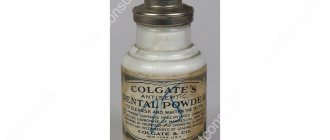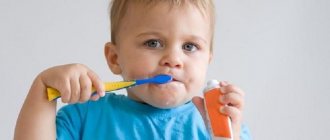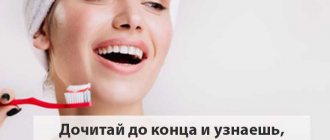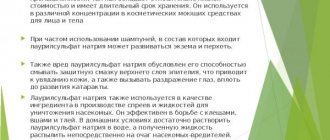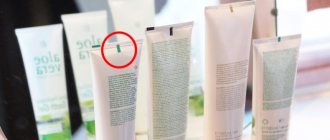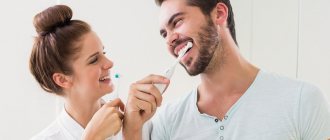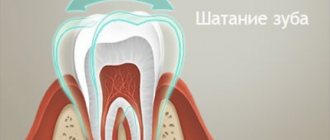Surely not everyone knows that toothpaste can be used not only for its intended purpose - to care for teeth and oral cavity. This product may be useful in some other hygiene and cosmetic procedures. For example, to combat problems with the skin of the face and décolleté. But these are very specific techniques, about which many dermatologists speak very negatively. But still, in some cases, small secrets for non-standard use of toothpaste can help solve certain appearance problems.
What substances are undesirable for facial cleansing?
Some active ingredients that may be included in oral care products can be irritating to the skin of the face.
- If your toothpaste contains sodium lauryl sulfate, triclosan, sodium fluoride, then you should note that these components have an active effect on the skin. Thus, sodium lauryl sulfate is a strong surfactant, triclosan is an antibacterial and antifungal substance with a wide spectrum of action, and sodium fluoride is a detergent, that is, an effective cleaning agent. All of them are active skin irritants, the effect of which, if possible, is only short-term and rare.
- Calcium carbonate, which can also be found in toothpaste, is a natural white food coloring.
- Zinc has a drying effect on the skin and has an antimicrobial effect.
- Gel toothpaste contains much more artificial chemical components than thick white toothpaste.
As you can see, you can’t just take the existing toothpaste from the bathroom shelf and try to solve your skin problems with it. First, carefully read its composition and decide for yourself whether it is worth resorting to such help.
Reviews
Judging by the reviews, a toothpaste face mask is highly effective. It copes well with acne, blackheads and pustules. The product is affordable for everyone, which is why it is so popular among teenagers, who often do not have the opportunity to buy expensive drugs.
After using a toothpaste mask, women note that their skin has become smoother, fresher, more even in color and toned. The result is almost like after an expensive salon procedure. But toothpaste is much cheaper, and it can be used as an express remedy for fresh skin before an important meeting.
In addition, toothpaste has been found to dry out the skin. Therefore, masks should not be used too often, and during the break you need to pamper your skin with nourishing fatty creams and oil-based masks.
Allergy tests
If you decide to try using toothpaste as an auxiliary means of caring for your skin and its problem areas, then first test its effect on an inconspicuous small area. Apply a very small amount of paste in the evening to the area under the chin and under the ear. After some time, remove the paste using a cotton pad soaked in warm water. Carefully inspect the places where the unusual hygiene product was located. If the skin becomes red or, on the contrary, becomes very discolored, a burning sensation appears and it begins to peel, then this toothpaste cannot be used to treat skin problems. Even while the paste is on the skin, listen carefully to your sensations - an unpleasant burning, tingling, itching sensation should alert you. It is best to immediately remove the toothpaste and not use it for other purposes.
How to remove and dry out pimples and redness with toothpaste: reviews
Reviews of people with acne problems about treatment with toothpaste
People who have encountered this problem share whether toothpaste helped remove acne on their face:
Anita, 28 years old . After giving birth, acne often began to appear on my face. Once, an employee recommended that I apply toothpaste to my inflamed pimples. I tried it and it helped. Only I keep the paste on my face for 15-20 minutes, and not the whole night.
Nadya, 15 years old . My friends and I use toothpaste to remove acne. It's very simple: we apply the paste in the evening and in the morning there is no pimple.
Vika, 25 years old . I have problem skin on my face, and I deal with it comprehensively, but sometimes it happens that a pimple appears in a visible place, then I use toothpaste. And it helps.
So, we have studied the method of removing acne with toothpaste.
Some rules and features
The difficulty in using toothpaste to care for facial skin is that no one can clearly say in what quantity it should be applied and how long to leave it on for an effective effect, because it is unusual to clean the skin of the face with toothpaste. Some people advise applying it directly to problem areas of the skin at night. But if you have sensitive skin, then within a few hours the paste can have a very negative effect and cause extensive irritation. If you want to use a paste to cleanse your face, use it for a short time to minimize any risk of skin damage. In addition, apply it directly to the problem area, being careful not to touch healthy skin.
The money tree pleases with lush flowering: my secret is in caring for the leaves
Rare shot: Viktoria Isakova showed her grown-up daughter from Yuri Moroz (new photo)
If there is little snow, there will be no harvest: December 16 is Ivan the Silent Day
Many of those who have used toothpaste to deal with skin inflammation believe that the paste must be left on for a sufficiently long time to be effective. But if the skin is sensitive, you should not do this, since instead of inflammation you can get severe irritation, which can again result in the development of an inflammatory process. Use this non-standard method only in emergency cases.
When and how many times should you brush your teeth?
You need to brush your teeth at least 2 times a day for 2 minutes, and you should try to distribute this time evenly over the entire dentition. It is best to brush your teeth before breakfast, since microorganisms accumulate in your mouth after sleep. Without brushing your teeth, you risk introducing pathogenic microflora into the stomach and intestines. In the evening, it is recommended to brush your teeth before going to bed and not eat after hygiene procedures.
Algorithm for proper brushing of teeth with conventional (traditional, manual) and electric brushes
It is recommended to follow the correct teeth brushing sequence:
- 1. First, rinse your brush or electric brush head under running water and apply a pea-sized amount of toothpaste to it.
- 2. Brushing your teeth begins with the outer surface of the side teeth, moving towards the middle. Proper brushing technique means holding the brush at a 45° angle. When using a regular toothbrush, it is necessary to perform the correct movements, namely, 4-5 sweeping movements from top to bottom on the upper jaw and from bottom to top on the lower jaw. When using an electric toothbrush, you do not need to make any movements other than moving it from the back teeth to the front ones, holding each for a few seconds without applying excessive pressure.
- 3. Then you need to perform similar actions on the inside.
- 4. Next, clean the chewing surfaces, also in the direction from the back teeth to the front, making circular movements.
- 5. Next you need to massage the gums with a brush using gentle circular movements. Electric toothbrushes have special attachments for the gums, palate and tongue.
- 6. Clean the surface of the tongue with a special device that should be on the brush, or use a special scraper for this.
- 7. At the end, clean the interdental spaces with dental floss, using a new piece of floss for each gap.
- 8. Finish brushing your teeth with a mouth rinse; you can use special rinses, which the doctor will help you choose at your appointment.
Using an irrigator
An irrigator is a device that uses a certain pressure to deliver a stream of water or antiseptic to clean the interdental spaces and other hard-to-reach areas, washing away plaque from the tooth enamel.
It must be used after brushing your teeth. Its use is most effective in the following cases:
- Wearing braces,
- The presence of bridges, crowns and implants,
- Tendency to form stones in interdental spaces, crowded teeth
- The occurrence of almond stones, causing bad breath.
The irrigator cannot be used for acute infectious and inflammatory diseases of the oral mucosa, damage to the oral cavity, or periodontitis.
How to wash off the paste?
If you do decide to use toothpaste, applying it to small areas of the skin to cope with inflammation, pimples, blackheads and acne, then after some time you need to wash it off. This should be done with lukewarm water, rubbing the skin in a circular motion, or with your fingertips, or with a cotton pad. Once the paste is completely removed from the skin, rinse your face with cool water to help soothe the skin. Then pat your face dry with a clean towel and apply moisturizer.
How to remove, dry out pimples and redness with toothpaste: effect
Skin after removing acne with toothpaste
After treating acne with toothpaste, the following positive effect :
- Enlarged pores of the skin on the face are cleansed and tightened
- Relieves facial skin inflammation
Comprehensive acne treatment methods will bring even greater effect:
- Eat only healthy foods (more raw vegetables and fruits)
- Walk a lot in the fresh air
- Quit all bad habits (smoking, alcohol)
- In the mornings and throughout the day, do as much physical exercise as possible.
Daily washing
If you have tested for allergies to a specific type of toothpaste, tried to remove inflammation from the skin with its help, and you succeeded, then this paste can be used as a means for daily washing. Naturally, there is no need to squeeze the paste into your palm, smear it over your face, and then wash off this mask with water. If you need to use fairly harsh facial cleansing for a couple of days to get rid of acne, for example, then do so. Take a clean cup and squeeze out half a teaspoon of paste into it. Pour a small amount of water into the cup and mix well to obtain a homogeneous liquid mass. Wash your face with the resulting product, gently massaging it onto the skin. Carefully monitor your sensations - if a burning sensation begins, immediately rinse the paste with warm water. A one-time wash with an unusual product will not help get rid of the problem, but if you use it for two or three days, it will significantly improve the condition of the skin, especially if you also use medications to eliminate the problem.
A student at the Vietnam Police Academy shared how she takes care of her facial skin.
Women's jeans: before you buy them, you need to pay attention to one detail
A Brazilian travels 36 km by bike every day to take his loved one home.
After using a toothpaste-based cleanser, be sure to lubricate your skin with a nourishing or moisturizing cream.
Indications for use
Using toothpaste for the face in the form of a mask is possible in the following cases:
- Against acne and pimples . The paste has bactericidal properties, destroying microorganisms that cause various rashes. In addition, the paste dissolves fats on the surface of the skin, which serve as a breeding ground for bacteria, and also reduces the secretion of the sebaceous glands.
- Against blackheads . In this case, a paste with hard abrasive particles will do, or you can simply add baking soda as a substitute.
- Facial cleansing . The principle is the same as with blackheads. In addition, the paste will help get rid of dead cells that prevent healthy skin from accessing oxygen and nutrients. The alcohol in the paste will dissolve fats and remove greasy shine.
- Tonic . The paste perfectly nourishes and tones the skin. It helps to penetrate deep into the facial tissues when used in combination with other products in the mask. The skin of the face takes on a healthy and ruddy appearance thanks to menthol and essential oils.
- Whitening and getting rid of freckles . The paste removes all pathologies on the face, brightening it and revealing healthy skin. At the same time, both freckles and other formations disappear. The pastes also contain special whitening components that will further enhance the effect.
What else will help your skin be clean and free of inflammation?
Yes, many toothpastes contain active ingredients that have anti-inflammatory, antibacterial, and drying effects. This is exactly what inflamed skin that is prone to pimples, acne, and irritation needs. But as a cosmetic product, toothpaste is not the best option. It’s better to find a suitable product for yourself from a pharmacy or a specialized department of a cosmetics store. Such products will contain salicylic acid, extracts of some medicinal plants, and bioactive components. It is better to use special care products and medications than experiment with toothpaste. Remember that dental care product should only be used in an emergency.
Can pregnant women apply toothpaste to acne?
Pregnant women should not remove acne with toothpaste.
If a woman has a tendency to develop acne on her face, it means that during pregnancy they can appear in large numbers on the face and body. There are several reasons for this :
- During pregnancy, the level of the hormone testosterone and progesterone increases, which means that the sebaceous glands work harder.
- Increased activity of the sebaceous glands due to stressful situations during pregnancy.
- If a woman drinks little fluid during pregnancy, sebum production may also increase.
How to treat acne for pregnant women?
Pregnant women cannot remove acne using toothpaste , since the skin is very sensitive to everything, but you can try the following folk methods :
- Vegetable and fruit masks
- Herbal infusions of calendula, chamomile, and ice from them
- Products for sensitive skin
Recipe 1. Cinnamon and honey acne mask
For the mask you need:
- 1 tsp. spoon of cinnamon powder
- 1 tsp. spoon of liquid flower honey
Preparing the mask:
- Mix cinnamon powder with honey.
- Apply to pimples in the evening.
- In the morning, wash off with warm water.
Recipe 2. Rubbing reddened facial skin with pumpkin
Redness on the face can be reduced by rubbing a piece of pumpkin on your face. Pumpkin keeps well in the refrigerator, and you can stock it for a long time. It is only important that you wipe your face with a new piece of pumpkin each time.
The main thing is expert advice
If the problem of the external condition of the skin of the face and décolleté is a constant or regularly occurring problem for you, then to eliminate it you need to consult with a specialist - a dermatologist. In the vast majority of cases, this condition of the skin is caused by problems with the internal organs and systems of the human body. If necessary, the doctor will recommend consultation with specialized specialists - nutritionist, endocrinologist, hematologist. Only a specialist can prescribe oral medications - antibiotics, hormonal medications, sedatives. Medicinal plants, which are recommended by the attending physician, effectively help in solving skin problems.
"Dad is offended." Agata Muceniece about her relationship with Priluchny after the divorce
Why French children behave well: eight ways to raise them
“We are still friends”: Derevianko commented on the breakup with his wife
Causes of gum sensitivity
The most common reasons include signs of disease and characteristics of the body or brushing teeth. Let's highlight the three most popular reasons.
Vigorous teeth brushing
Many people believe that in order to get a good cleaning, you need to press harder on the brush. And it’s even better if this brush has stiff bristles and the abrasiveness index of the paste is maximum. But if you are prone to sensitivity, this approach is especially harmful.
For thorough cleaning, soft bristles and low-abrasive paste are sufficient. And the cleaning technique does not have to be intensive. We wrote more about the techniques in the article “How to properly brush your teeth with a manual brush.”
Changes in hormone levels
Increased sensitivity of the gums is often observed in diseases of the endocrine and nervous systems, as well as in women during pregnancy. Changes in hormone levels lead to a deterioration in the blood supply to the mucous membrane. In addition, the number of bacteria in the oral cavity increases, and the enamel does not receive enough minerals.
Irritation from dental plaque
Irritation of dentin tissue is natural during the formation of dental plaque - a formation that can create an acidic environment in the oral cavity. Plaque is a mixture of bacteria, food debris, saliva and mucus with calcium and phosphate salts.
Poor hygiene leads to plaque accumulation, which pushes the gum away from the tooth. This causes redness and irritation of the gums. And subsequently gingivitis and even periodontitis.
Tea tree
Tea tree leaf extract has been known for its antibacterial properties for centuries. Today you can buy the oil of this plant in pharmacies and cosmetics stores. Apply it with a cotton swab to the problem area - redness or pimple. The oil will have the desired therapeutic effect, while allergies to its components occur in extremely rare cases.
Types of inflammatory gum diseases
We looked at the reasons that are not related to diseases. Now let's talk about what types of inflammations you should go to the doctor for. These include the three most common diseases: gingivitis, periodontitis and periodontal disease. Let's look at each of them in more detail.
Gingivitis
Gingivitis is an inflammation of the dentin tissue around a specific tooth. It occurs in both chronic and acute forms. The inflammatory process manifests itself only on the gums, without affecting the tooth tissue. Therefore, it is quite simple to cope with gingivitis before it progresses to the stage of periodontitis.
Periodontitis
Periodontitis is the inflammation of the tooth tissues that support it. This tissue is located between the root of the tooth and the jaw bone. The disease gradually moves the gum away from the tooth, forming a gum pocket. In other words, the gums expose the teeth, and they become sensitive. Food gets clogged into the gum pockets, pus appears in the acute phase, and the teeth gradually become loose and shift.
Inflammatory diseases are easy to distinguish by visual examination: with gingivitis - only redness and swelling, with periodontitis - also receding gums
Papaya
Papaya seed extract is a unique remedy for facial skin. It not only helps get rid of acne and redness, but has a rejuvenating effect due to its exfoliating effect, leaving the skin filled with radiance and freshness. This is a biological process carried out through the action of a specific enzyme, papain, which affects inactive protein bonds, causing them to disintegrate, due to which the removal of dead epithelial cells occurs.
Found a violation? Report content
How to use an irrigator correctly
The first step is to fill the reservoir with liquid.
There are special rinses and balms for the irrigator, but if they are not available, you can pour filtered boiled water. At the beginning of use, it is recommended to set the power of the irrigator to a minimum in order to prevent injury to the gums by a strong jet of water. You can gradually increase the pressure so that the procedure is comfortable. The irrigator is placed in the oral cavity, leaving a distance of several millimeters between the nozzle and the teeth. It is better to keep your mouth slightly open. Start cleaning from distant areas, moving the nozzle to the middle. The jet is directed from the gum to the crown at an angle to clean the enamel surface from plaque. Then - into the gum pocket to remove washed away plaque. You need to linger on the interdental spaces for a few seconds.
Dentists advise using the irrigator once a day. If teeth are prone to increased plaque and tartar formation, you can use the irrigator more often, including after meals. However, this device should not be abused, since too frequent exposure to a stream of water under pressure can disrupt the tight fit of the gums to the teeth, thereby increasing the distance between the teeth and gums.
After each use, it is necessary to rinse the irrigator with water, dry it and store it in a dry place. It is recommended to wash the irrigator once a month using special cleaning products.
Side effects
When using an active product, you need to remember that there is a risk of damaging the skin. After exposure, the following may appear:
- irritation;
- itching;
- peeling;
- whitish spots;
- increased redness.
The components accelerate the maturation of acne papules, so the next morning white pustules may appear, which will soon dry out. Menthol, contained in some brands, gets into the eyes and causes burning and watery eyes. Rash located close to the eyelids must be lubricated with other means.
The main danger of use is allergic reactions. In this case, the acne will not disappear, but the problem will only get worse. Each new product must pass a skin test on the back of the hand.
Toothpaste is used as a remedy for facial acne only when the cosmetic problem is caused by bacteria. In other cases, it is used to reduce redness.
Contraindications
Like any anti-acne cosmetic product, the paste has a number of contraindications that you need to remember when starting acne treatment.
Use is prohibited or undesirable:
- people with dry sensitive skin;
- children under 12 years old;
- for dermatitis and allergies;
- pregnant and lactating women;
- for blood diseases.
It is dangerous to use a folk recipe for systemic diseases such as lupus erythematosus, scleroderma, hemophilia.
Attention!
If itching and burning occurs, you must immediately wash off the paste with water and lubricate your face with panthenol or baby cream.
